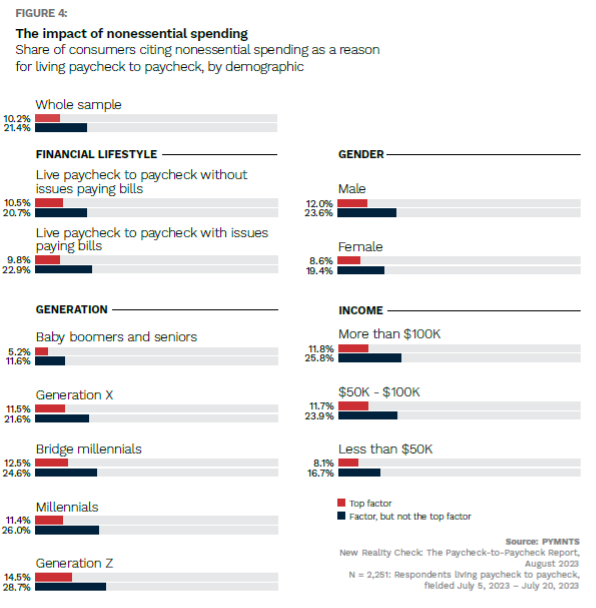
Living paycheck to paycheck is a harsh reality for millions of individuals in the U.S., and nonessential spending plays a key role in adding to the financial burden on these cash-strapped consumers.
In the “New Reality Check – The Paycheck-to-Paycheck Report: The Nonessential Spend Deep Dive Edition” report, PYMNTS draws on insights from a survey of more than 3,400 U.S. consumers to examine the impact of nonessential spending on consumers’ ability to manage expenses and put aside savings.

According to findings detailed in the study done jointly by PYMNTS and LendingClub, 10% of all paycheck-to-paycheck consumers, representing 16 million individuals in the United States, consider nonessential spending the primary reason they struggle to make ends meet.
Additionally, 21% of these consumers cite nonessential spending as one of the reasons for their financial struggles. This indicates that 6.2% of the U.S. adult population can be classified as “discretional” paycheck-to-paycheck consumers, while 13% live paycheck to paycheck partly due to nonessential spending.
The study further shows that the likelihood of nonessential spending as a reason for living paycheck to paycheck varies across different demographics.
Baby boomers and seniors are less likely to attribute their financial situation to nonessential spending, with only 12% mentioning it as a factor. In contrast, 29% of Generation Z consumers believe nonessential spending affects their financial lifestyle. Interestingly, high earners with over $100,000 in annual income are more likely (26%) to cite nonessential spending as a reason for living paycheck to paycheck compared to low-income consumers (17%).
The study also reveals differences in shopping habits among consumers, both those living paycheck to paycheck and those who do not face such financial constraints. Approximately 74% of consumers admit to occasionally including nonessential items in their grocery carts, while 70% do the same during retail shopping.
Also, among paycheck-to-paycheck consumers who manage to pay their bills without issues, 72% acknowledge buying “nice-to-have” grocery items at least sometimes, while 69% do the same for retail items. Conversely, nearly 60% of paycheck-to-paycheck consumers who struggle to pay their bills admit to occasionally purchasing nonessential grocery or retail items.
Overall, understanding the impact of nonessential spending on personal finances can help individuals make more informed decisions about their spending habits, potentially breaking free from the paycheck-to-paycheck cycle and achieving greater financial stability.